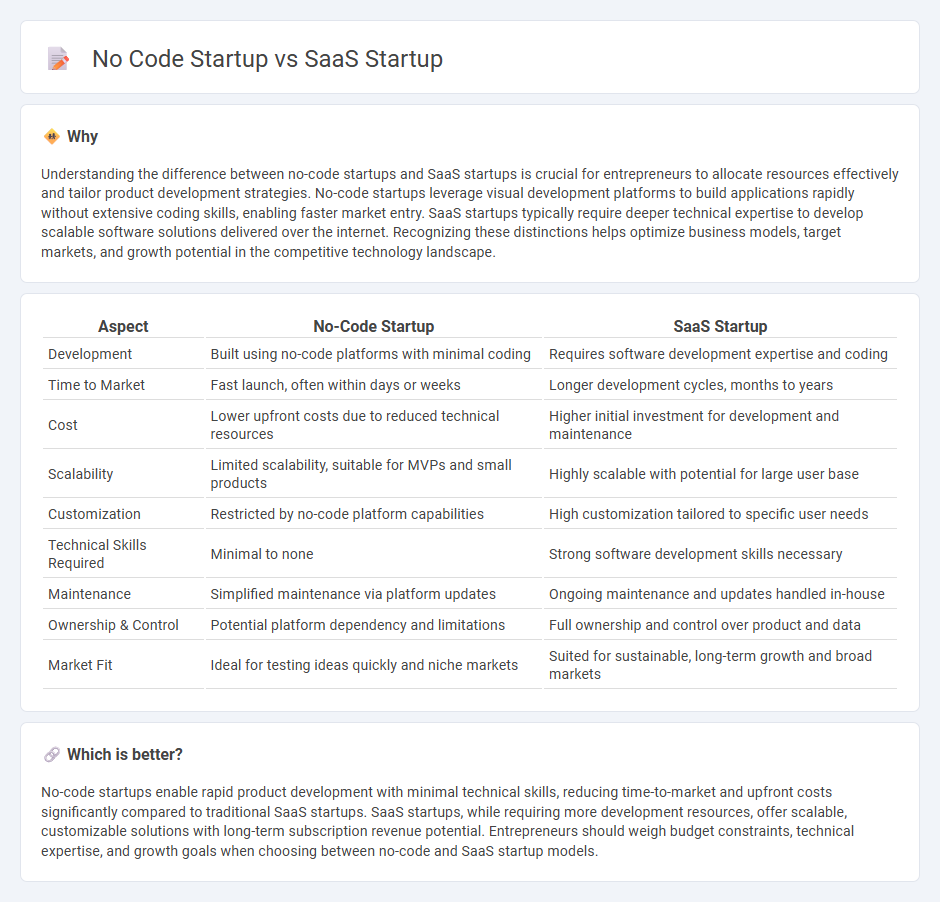
No-code startups empower founders to create software applications without traditional programming, significantly reducing development time and costs while accelerating market entry. SaaS startups focus on delivering subscription-based software solutions hosted in the cloud, offering scalability and continuous updates to users. Explore the advantages and challenges of each model to determine the best path for your entrepreneurial journey.
Why it is important
Understanding the difference between no-code startups and SaaS startups is crucial for entrepreneurs to allocate resources effectively and tailor product development strategies. No-code startups leverage visual development platforms to build applications rapidly without extensive coding skills, enabling faster market entry. SaaS startups typically require deeper technical expertise to develop scalable software solutions delivered over the internet. Recognizing these distinctions helps optimize business models, target markets, and growth potential in the competitive technology landscape.
Comparison Table
| Aspect | No-Code Startup | SaaS Startup |
|---|---|---|
| Development | Built using no-code platforms with minimal coding | Requires software development expertise and coding |
| Time to Market | Fast launch, often within days or weeks | Longer development cycles, months to years |
| Cost | Lower upfront costs due to reduced technical resources | Higher initial investment for development and maintenance |
| Scalability | Limited scalability, suitable for MVPs and small products | Highly scalable with potential for large user base |
| Customization | Restricted by no-code platform capabilities | High customization tailored to specific user needs |
| Technical Skills Required | Minimal to none | Strong software development skills necessary |
| Maintenance | Simplified maintenance via platform updates | Ongoing maintenance and updates handled in-house |
| Ownership & Control | Potential platform dependency and limitations | Full ownership and control over product and data |
| Market Fit | Ideal for testing ideas quickly and niche markets | Suited for sustainable, long-term growth and broad markets |
Which is better?
No-code startups enable rapid product development with minimal technical skills, reducing time-to-market and upfront costs significantly compared to traditional SaaS startups. SaaS startups, while requiring more development resources, offer scalable, customizable solutions with long-term subscription revenue potential. Entrepreneurs should weigh budget constraints, technical expertise, and growth goals when choosing between no-code and SaaS startup models.
Connection
No code startups accelerate SaaS development by enabling entrepreneurs to launch scalable software solutions without extensive coding knowledge, reducing initial costs and time-to-market. SaaS startups leverage no code platforms to rapidly prototype, iterate, and deploy their applications, facilitating agile product management and customer feedback integration. This synergy democratizes software innovation, allowing founders to focus on business growth and user experience rather than technical complexities.
Key Terms
Scalability
SaaS startups typically offer scalable software solutions through custom-built platforms that handle increasing user demand and complex integrations efficiently. No-code startups emphasize rapid development and deployment with user-friendly tools but may encounter scalability limitations due to platform constraints and less flexibility in customization. Explore the key differences in scalability strategies between SaaS and no-code startups to make an informed decision for your business growth.
Customization
SaaS startups prioritize deep customization options that allow users to tailor software functionalities to specific business requirements, enhancing scalability and integration capabilities. No code startups focus on empowering non-technical users with drag-and-drop interfaces for rapid application development, though customization is often limited compared to traditional SaaS. Explore detailed comparisons to understand the best fit for your business needs and technical capabilities.
Technical Barrier
SaaS startups typically involve higher technical barriers due to custom software development, requiring skilled engineers to build and maintain scalable, secure platforms. No code startups leverage drag-and-drop tools and pre-built components, significantly lowering the technical entry point and accelerating product iteration cycles. Explore the distinct technical challenges and opportunities in SaaS and no code startups to choose the best fit for your venture.
Source and External Links
Top 25 SaaS Startup Ideas to Launch in 2025 - SpdLoad - This article outlines promising SaaS startup ideas and emphasizes the importance of product discovery, UI/UX design, and agile MVP development for launching a successful SaaS business in 2025.
10 Steps to Start a Successful SaaS Company in 2025 - LivePlan - This resource provides a step-by-step guide to building a SaaS startup, focusing on solving real problems, validating ideas, and exploring pricing models to build a foundation for success.
Software as a service - Wikipedia - Offers a comprehensive explanation of the SaaS model, its cloud-based delivery, multi-tenant architecture, and typical business models like subscription and freemium, explaining the technical and economic aspects of SaaS startups.
 dowidth.com
dowidth.com